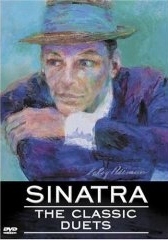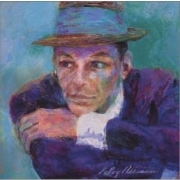The
Frank Sinatra Show
(1957-1958)
By Jim Davidson
Posted
10/15/2006
| 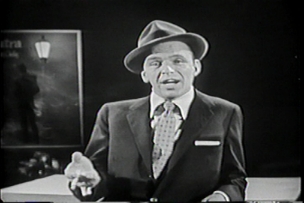
With
Chesterfield as a sponsor, Frank smoked a lot of cigarettes on the air.
Some
of the biggest stars in show business guest starred on The Frank Sinatra Show. 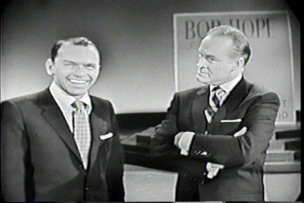
Bob Hope
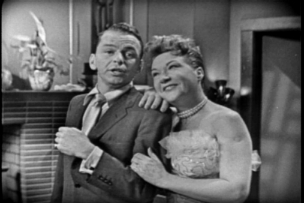
Ethel Merman
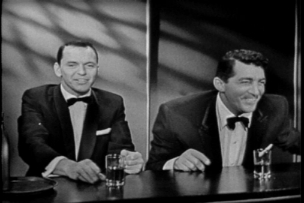
Dean Martin
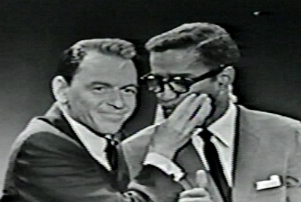
Sammy Davis Jr.
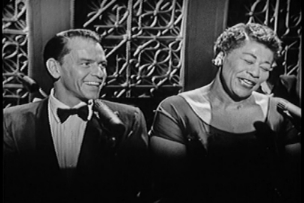
Ella Fitzgerald
|
| The
TV Sinatra Duet
performances from Sinatra's 1957-1960 TV shows were collected in a 2002 PBS special
(featuring commentary by Nancy, Frank Jr., and Tina Sinatra) that's now available
on both DVD
(left) and CD
(right). (These are paid links.) Another PBS special, called Vintage Sinatra, airing in 2003 and
featuring the singer's solo performances, has yet to be released. | | |
Frank Sinatra's second
attempt at a TV show came just five years after the first. But despite their close
proximity, the two programs were as different as...well, night and day (to borrow
a song title from Cole Porter). Sinatra's
career experienced a dramatic upswing in 1953, primarily due to two events. The
first was signing with Capitol Records, where he began recording with arranger
Nelson Riddle. Though Riddle's roots were in the same 1940s big band swing style
as those of previous musical director Axel Stordahl, his arrangements were more
imaginative and contemporary. Having a new, more exciting backdrop to sing with
inspired Sinatra to new heights of musical eloquence. He began to feature more
uptempo songs and adopted a new, more mature image. Gone was the boy balladeer,
to be replaced by the sybaritic swinger. As his record sales picked up, Sinatra
found himself back on top of the music business.
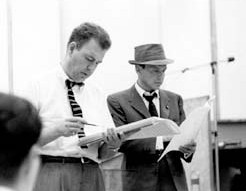 |
| Nelson
Riddle's arrangements were a major factor in Frank Sinatra's resurgence. |
The other
important event for Sinatra that year was his supporting role in the film From
Here to Eternity, garnering him an Academy Award. No longer viewed merely
as a pop singer, Sinatra was now a sought-after dramatic actor. Suddenly,
everyone wanted him, including the big three TV networks. There was talk of a
fifteen-minute twice-a-week early evening show on NBC and a dramatic series produced
by Desilu. Sinatra was even scheduled to host The Colgate Comedy Hour on
November 15, 1953, but that plan fell through.
The star wasn't really interested in the grind of a weekly TV program anyway,
particularly a variety show. "I'm getting too old to bounce around a stage,"
he was quoted as saying at the time. What he really wanted was to do drama. The
networks held out for a variety series, and eventually a compromise was struck
with ABC. Starting in the fall
of 1957, the singer was to appear in a weekly half-hour hybrid show - with 13
variety episodes, 13 dramas starring Sinatra, and 10 dramas hosted by Sinatra.
The premiere would be a full hour of variety. Sinatra
wanted to do the show on film to enhance its rerun value. But since that would
have been expensive, he agreed to do some of the variety episodes live-on-kinescope
- in other words, performed as if they were live, but filmed and shown at a later
date. It was a technique pioneered by Bob Hope. The
deal, worth a reported $3,000,000, called for the star's Hobart Productions to
run the show. But despite light
competition from the other networks (M Squad on NBC and Mr. Adams &
Eve on CBS), it didn't score very well in the ratings. One thing became clear
immediately, though - the public was far more enthusiastic about the variety shows
than the dramas. As a result, several of the dramas were hastily replaced on the
schedule by variety segments, and the ratio of variety to drama episodes was increased.
The eventual breakdown ended up being 14 live variety, 8 filmed variety, 4 dramas
starring Sinatra, and 6 dramas hosted by Sinatra. Instead of 36 episodes for the
season, ABC decided to cut its losses and reduce the number to 32. 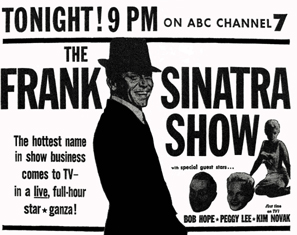
Sinatra
was accused of not taking the enterprise seriously, and more than one insider
told of the star's habit of showing up late for rehearsals and refusing to do
more than one take per scene. His supporters, however, pointed out that Frank
was a busy man, with movie, recording, and production responsibilities, in addition
to singing and acting in his show. By
mid-season, the threat of cancellation looming, Sinatra agreed to defer his other
commitments and focus entirely on the show. An agency executive said at the time,
"He realizes he has to be the old warm and charming Sinatra again. He accepted
criticism and sought advice as if he were a newcomer to show business." The
star even went on other TV shows to plug his own program, but
the effort was too late. At the end of June, ABC decided it was time to cash in
its chips. Several
reasons have been given for Sinatra's lack of success on TV. Historian Albert
Auster suggests that the singer was, in McLuhanesque terms, too "hot"
for the "cool" medium of television (belied by the fact that his mid-sixties
specials were so successful), that there were too many in-jokes, and that the
star was bucking the trend toward rock 'n roll (even though singers like Perry
Como and Dinah Shore - hardly rock 'n rollers - were doing quite well on TV).
But producer William Self may have put his finger on the most important reason:
"I think the problem was, the audience didn't know what they were going to get
when they tuned in. With Lucy, you knew what you were going to get; with
Gunsmoke, you knew what you were going to get. You tuned in to the Sinatra
show, and he's not singing this week; he's going to do a little dramatic show.
And the show had a tough rating haul because of that." Daughter Tina Sinatra was
more succinct: "He had to fail somewhere." Despite
the show's uneveness and deficient ratings, there are many wonderful moments.
Here we have Sinatra in his prime, singing many of his hits when they were still
fresh and exciting. It's a shame the program didn't last longer, but we should
be grateful for what we have.
| Dueling
Sponsors and Networks We
tend to think of the 1950s as the golden age of television - a more innocent time
when everyone was happy. But behind the scenes, things weren't always so golden.
Back then, sponsors had far more influence over the shows they sponsored than
they do today. Stars were obliged to hawk the sponsor's products at every turn
- which sometimes got them into trouble. In
1951, Frank Sinatra managed to rile Lucky Strike when he guest starred on the
LS-sponsored Jack Benny Show the same week he substitute hosted for Perry
Como and declared, "Chesterfield's my favorite brand." Just
prior to starting his second series, on ABC, Sinatra stirred up more controversy
when he agreed to appear on CBS's Club Oasis. This time, the conflict wasn't
with the sponsor; both shows were underwritten by Liggett & Myers (makers
of Chesterfield and Oasis cigarettes). But ABC had an exclusive contract with
the singer and didn't want him on a rival network. In the end, ABC approved the
guest shot, reasoning that it was best not to upset a powerful sponsor. Bob
Hope wasn't so lucky. After guesting on the premiere of The Frank Sinatra Show
(sponsored in part by Bulova watches), his sponsor Timex dropped him. Hope's network
NBC threatened to sue Timex for breach of contract, but once again, the sponsor
won out. Hope had to scramble to come up with a replacement. |
| |
| Series
# | Season
# | Airdate |
Cast |
| 001 |
1-01 |
10/18/1957 |
Bob Hope, Peggy Lee, Kim
Novak; cameo by Jeff Chandler (live)
Note: Frank sings "Lonesome Road,"
"I Get a Kick Out of You," "The Lady is a Tramp," "All
the Way," and "Bewitched, Bothered and Bewildered" and does tongue-in-cheek
renditions of "I Could Write a Book" and "Autumn Leaves."
Peggy sings "Listen to the Rockin' Bird" and "He's My Guy"
(the latter with Frank conducting). Jerry Colonna appears in one of the Chesterfield
commercials. This episode was an hour long. Frank and Bob joke about Mike Todd's
star-studded dinner party, televised on Playhouse 90 the night before.
"I'm a little tired. I've been helping Mike Todd with the dishes," quips
Bob. They also make reference to The Edsel Show the previous Sunday, hosted
by Bing Crosby, featuring Frank as a guest and Bob in a cameo. In a prescient
forecast of his host's TV career, Bob remarks, "Frank, you just can't plunge
into television without some preparation." Variety acknowledged the
deficiencies in the comedy material but thought Sinatra's songs were "enormous
pluses." |
| 002 |
1-02 |
10/25/1957 |
"That Hogan Man"
(film)
Note: Frank plays a single cab driver in New York whose friends and
adopted young children try to play matchmaker for him. |
| 003 |
1-03 |
11/1/1957 |
Nancy Sinatra, Jane Ross, Belinda Burrell (film)
Note: Frank's eldest daughter,
17-year-old Nancy, joins forces with two schoolmates, Jane and Belinda, to form
a trio called The Tri-Tones to perform "Side by Side" with Frank. On
his own, Frank sings "I've Got You Under My Skin," "Violets for
Your Furs," "The Girl Next Door," "It Happened in Monterey,"
and "You'd Be So Nice to Come Home To." |
| 004 |
1-04 |
11/8/1957 |
Peggy Lee (film)
Note: Frank and Peggy team up for "Love Is Here To Stay"
and "Nice Work If You Can Get It." The dramatic episode "Brownstone
Incident" was originally scheduled to air on this date. |
| 005 |
1-05 |
11/15/1957 | The
McGuire Sisters (film)
Note: Frank sings "From This Moment On,"
"Three Coins in the Fountain," "Where Are You?" "I Got
I Bad and That Ain't Good," and "Baby Won't You Please Come Home."
The McGuire Sisters do "Them There Eyes" and join Frank for "Something's
Gotta Give." |
| 006 |
1-06 |
11/22/1957 | Erin
O'Brien (film)
Note: Frank sings "Wrap Your Troubles in Dreams,"
"I Get Along Without You Very Well," "My Funny Valentine,"
"I Wish I Were in Love Again," "I'm Gonna Sit Right Down and Write
Myself a Letter," and "One For My Baby." Erin does "I'm Glad
There is You" and joins Frank for "Let's Get Away From It All." |
| 007 |
1-07 |
11/29/1957 | Dean
Martin (film)
Note: Frank sings "Night and Day," "Old Devil
Moon," and "The House I Live In." Dean sings "They Didn't
Believe Me." Frank and Dean take turns in a medley of their hits: "Sunday,
Monday Or Always," "On a Slow Boat to China," "Saturday Night
is the Loneliest Night of the Week," "Memories Are Made of This,"
"The Girl That I Marry," "Innamorata," "I've Got a Crush
On You," "Oh Marie," and "Don't Cry Joe." Vic Tanner
plays the little old lady who helps Dean onto the stage. The dramatic episode
"A Gun At His Back" was originally scheduled to air on this date. |
| 008 |
1-08 |
12/6/1957 | "A
Gun At His Back" (film)
Frank Sinatra, Pat Crowley, Harold J. Stone,
Sean McClory, Ray Ferrell, Steve Conte
Note: When the police fail to locate
his stolen cab, a taxi driver (played by Frank) decides to take matters into his
own hands. |
| 009 |
1-09 |
12/13/1957 |
"Take Me To Hollywood"
(film)
Frank Sinatra (Kerry), Christine White (Janice), Celia Lovsky (Madame
Blausky), Maurice Manson (B. J. Kaye), Irene Seidner (Hermine)
A talent scout
is assigned the task of turning an inexperienced starlet into a polished actress
but finds himself falling in love with her. |
| 010 |
1-10 |
12/20/1957 |
"Happy Holidays with Bing and
Frank" (film/color)
Bing Crosby, The Ralph Brewster Singers
Note:
In this Christmas show, Frank sings "Mistletoe and Holly" (which he
co-wrote), "It Came Upon a Midnight Clear," and "Santa Claus Is
Comin' to Town." Bing croons "Away in a Manger" and "Rudolph
the Red-Nosed Reindeer." The two team up for "Jingle Bells," "Deck
the Halls," "God Rest Ye Merry Gentlemen," "Hark, the Herald
Angels Sing," "O Come, All Ye Faithful," "O Little Town of
Bethlehem," "The Christmas Song," and "White Christmas."
The Ralph Brewster singers perform "Here We Come a-Caroling" and "The
First Noel." This episode was directed by Frank and written by Bill Morrow.
Produced at the Samuel Goldwyn Studios using the drama episodes crew, it was shot
in color but originally broadcast in black and white. At a 2001 Museum of Television
and Radio seminar, producer William Self explained the rather unusual production
method: "Crosby liked to pre-record and lip synch, and he preferred doing it in
the morning. Frank liked to record live and do it in the evening. So these duets
were sung about ten hours apart, and we put it all together. There was no orchestra
there. Bill Miller, who was a wonderful pianist, played low so the mike would
not pick it up - or very much. And then Frank would sing to the low piano. And
then Nelson Riddle came in later and overrode the piano with the orchestra."
Buy
this episode (paid link) |
| 011 |
1-11 |
12/27/1957 | "The
Feeling Is Mutual" (film)
David Wayne, Janice Rule, Hugh Sanders, Dodie
Wright, Sydney Smith, Benny Rubin
Note: Frank hosts this tale of two lonely,
disillusioned people who strike up a friendship in Central Park. |
| 012 |
1-12 |
1/3/1958 | Dinah
Shore (live)
Note: Frank sings "Come Fly With Me," "Road to
Mandalay," "London by Night," and "April in Paris." Dinah
duets with Frank on "It's Nice to go Trav'ling" and "Autumn in
New York." |
| 013 |
1-13 |
1/10/1958 | Robert
Mitchum (live)
Note: Frank is happy to perform at a high school prom, but
the students want a rock 'n roll star instead. |
| 014 |
1-14 |
1/17/1958 | Louis
Prima, Keely Smith, Sam Butera and the Witnesses (film)
Note: Frank joins
Louis and Keely for "I Can't Believe That You're In Love With Me." The
dramatic episode "A Time to Cry" was originally scheduled to air on
this date. |
| 015 |
1-15 |
1/24/1958 |
Jo Stafford (live)
Note: Frank and Jo remember the good old days when both sang with Tommy Dorsey's
Orchestra. |
| 016 |
1-16 |
1/31/1958 | Sammy
Davis Jr. (film)
Note: Frank sings "Isle of Capri," "You Make
Me Feel So Young," "Tell Her You Love Her," and "I've Got
You Under My Skin." Sammy does impressions and dances. Together, they do
"Me and My Shadow." |
| 017 |
1-17 |
2/7/1958 | Jeannie
Carson (film)
Note: Frank sings "South of the Border," "They
Can't Take That Away From Me," "Lonely Town," "Walkin' My
Baby Back Home," and "Witchcraft." Jeannie does "The Boy Next
Door" and "Them There Eyes." | |
018 |
1-18 |
2/14/1958 |
Shirley Jones, Alice Pearce,
Nancy Sinatra (live)
Note: Frank sings "My Funny Valentine" to Nancy.
His nine-year-old daughter Tina was supposed to appear instead but got stage fright
at the last minute and was hastily replaced by her older sister. Together, Frank
and Shirley sing "If I Loved You." |
| 019 |
1-19 |
2/21/1958 | "A
Time To Cry" (film)
Anne Bancroft, Lloyd Bridges, John Archer, Ray Teal
Note: Frank hosts this drama in which a murderer holds a woman hostage in her
frontier cabin. |
| 020 |
1-20 |
2/28/1958 | Van
Johnson, Joi Lansing, Nancy Kulp (film)
Note: Frank sings "Come Fly With
Me," "I Could Write a Book," "There's No You," "At
Long Last Love," and "Put Your Dreams Away." Van joins him for
"Nothing in Common." |
| 021 |
1-21 |
3/7/1958 | Edie
Adams, Stan Freberg (film)
Note: Frank sings "I'm Gonna Live Till I Die,"
"This Can't Be Love," "All of Me," and "One For My Baby,"
and Edie sings "It's Love." Stan interviews a creature from the moon. |
| 022 |
1-22 |
3/14/1958 | Eydie
Gorme, Joey Bishop (film)
Note: Frank sings "It Happened in Monterey,"
"Moonlight in Vermont," and "The Most Beautiful Girl in the World."
Eydie sings "When Your Lover Has Gone" and "Gypsy in My Soul"
and joins Frank for "Saturday Night is the Loneliest Night of the Week." |
| 023 |
1-23 |
3/21/1958 | "The
Man On The Stairs" (film)
Michael Rennie, Marisa Pavan, Irene Tedrow,
Oliver McGowan
Note: Frank is host for this story about a young dancer who
is attracted to a moody painter in her New York apartment building. |
| 024 |
1-24 |
3/28/1958 | Eddie
Fisher, Jesse White (film)
Note: Frank and Eddie team up for "It's Nice
to Go Trav'ling" and a medley of "All the Way," "Oh, My Papa,"
and "Young at Heart." |
| 025 |
1-25 |
4/4/1958 | Spike
Jones, Helen Grayco, Jesse White (film)
Note: Frank sings "You Brought
a New Kind of Love To Me," "Too Marvelous for Words," and "Chloe."
He and Helen sing "Makin' Whoopee." Spike and his band destroy "Fascination,"
"All the Way," "Tammy," and "By the Light of the Silvery
Moon." |
| | | 4/11/1958 | Repeat
of 1/17/1958 episode |
| 026 |
1-26 |
4/18/1958 | "Brownstone
Incident" (film)
Frank Sinatra, Cloris Leachman, Anne Seymour, Phillip
Pine, Jack Albertson
Note: Frank stars with Cloris Leachman in this story
about a married couple in a heat wave, disagreeing about moving from the city
to the suburbs. |
| 027 |
1-27 |
4/25/1958 | Ethel
Merman, Jesse White, Lew Gallo (live)
Note: Frank sings "Just One of
Those Things," "You're Getting To Be a Habit With Me," and "I
Get a Kick Out of You." Ethel does "Zing Went the Strings of My Heart"
and "I'm Always Chasing Rainbows." Together, playing a famous show biz
couple surprised at home by a TV interviewer, they perform "You're the Top." | |
| |
5/2/1958 | Repeat
of 2/7/1958 episode |
| 028 |
1-28 |
5/9/1958 | Ella
Fitzgerald (live)
Note: Frank sings "Jeepers Creepers," "On
the Road to Mandalay," and "We'll Be Together Again." Ella does
"April in Paris," "Angel Eyes," and "When You're Smiling"
and joins Frank for "Moonlight in Vermont" and "I May Be Wrong." |
| 029 |
1-29 |
5/16/1958 | "The
Green Grass of St. Theresa" (film)
Wally Cox
Note: Wally plays Father
Dvorak, a priest who returns to his boyhood parish to find the church badly in
need of renovation. Frank hosts. |
| 030 |
1-30 |
5/23/1958 | Natalie
Wood, Pat Suzuki (live)
Note: Frank sings "Night and Day," "Lonely
Town," "I Believe," and "How Are Ya' Fixed For Love?"
Pat sings "From This Moment On" and "Something's Gotta Give."
Frank and Natalie duet on "Them There Eyes." |
| 031 |
1-31 |
5/30/1958 | "Face
of Fear" (film)
Glynis Johns, Michael Pate, Eugene Martin, Katharine
Warren
Note: Frank hosts this tale about a new governess who is suspicious
when she finds that her young charge is fear-stricken, and the boy's father won't
talk about his wife's disappearance. |
| 032 |
1-32 |
6/6/1958 | "The
Seedling Doubt" (film)
Phyllis Thaxter, MacDonald Carey, Edgar Stehli,
Irving Bacon
Note: In this Sinatra-hosted drama, a woman returns home after
a stint in a mental hospital only to wonder if her husband is really who he appears
to be. |
| | | 6/13/1958 | Repeat
of 12/6/1957 episode - "A Gun At His Back" |
| |
|
6/20/1958 | Repeat
of 12/13/1957 episode - "Take Me to Hollywood" |
| | | 6/27/1958 | Repeat
of 12/27/1957 episode - "The Feeling Is Mutual" |
| | | | Replaced
by the game show ESP |
|






